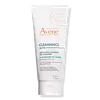What's inside
What's inside
 Key Ingredients
Key Ingredients

 Benefits
Benefits

 Concerns
Concerns

 Ingredients Side-by-side
Ingredients Side-by-side

Salicylic Acid
MaskingWater
Skin ConditioningSodium Cocoyl Isethionate
CleansingCocamidopropyl Hydroxysultaine
CleansingPropanediol
SolventStearyl Alcohol
EmollientCoco-Glucoside
CleansingSodium Lauroyl Sarcosinate
CleansingBetaine
HumectantGlyceryl Laurate
EmollientSodium Chloride
MaskingGlycerin
HumectantCetearyl Olivate
Hydroxypropyl Methylcellulose
Emulsion StabilisingSodium Benzoate
MaskingSaccharide Isomerate
HumectantSorbitan Olivate
EmulsifyingHydroxypropyl Guar Hydroxypropyltrimonium Chloride
Xanthan Gum
EmulsifyingTrisodium Ethylenediamine Disuccinate
Potassium Sorbate
PreservativeLactobacillus Ferment Lysate
Skin ConditioningCitric Acid
BufferingSodium Citrate
BufferingAcrylates Copolymer
Salicylic Acid, Water, Sodium Cocoyl Isethionate, Cocamidopropyl Hydroxysultaine, Propanediol, Stearyl Alcohol, Coco-Glucoside, Sodium Lauroyl Sarcosinate, Betaine, Glyceryl Laurate, Sodium Chloride, Glycerin, Cetearyl Olivate, Hydroxypropyl Methylcellulose, Sodium Benzoate, Saccharide Isomerate, Sorbitan Olivate, Hydroxypropyl Guar Hydroxypropyltrimonium Chloride, Xanthan Gum, Trisodium Ethylenediamine Disuccinate, Potassium Sorbate, Lactobacillus Ferment Lysate, Citric Acid, Sodium Citrate, Acrylates Copolymer
Ingredients Explained
These ingredients are found in both products.
Ingredients higher up in an ingredient list are typically present in a larger amount.
Coco-Glucoside is a surfactant, or a cleansing ingredient. It is made from glucose and coconut oil.
Surfactants help gather dirt, oil, and other pollutants from your skin to be rinsed away.
This ingredient is considered gentle and non-comedogenic. However, it may still be irritating for some.
Learn more about Coco-GlucosideSalicylic Acid (also known as beta hydroxy acid or BHA) is a well-known ingredient for treating skin that struggles with acne and clogged pores. It exfoliates both the skin's surface and deep within the pores to help clear out buildup, control oil, and reduce inflammation.
Unlike AHAs (alpha hydroxy acids), salicylic acid is oil-soluble. This allows it to penetrate into pores which makes it especially effective for treating blackheads and preventing future breakouts.
Salicylic acid is also known for its soothing properties. It has a similar structure to aspirin and can calm inflamed or irritated skin, making it a good option for acne-prone skin that is also sensitive.
Concentrations of 0.5-2% are recognized by the U.S. FDA as an over-the-counter topical acne product.
It can cause irritation and/or dryness if one's skin already has a compromised moisture barrier, so it's best to focus on repairing that before introducing this ingredient into your routine.
While salicylic acid does not increase sun sensitivity, it’s still important to wear sunscreen daily to protect your skin.
If you are looking for the ingredient called BHA or Butylated Hydroxyanisole, click here.
Learn more about Salicylic AcidSodium Benzoate is a preservative. It's used in both cosmetic and food products to inhibit the growth of mold and bacteria. It is typically produced synthetically.
Both the US FDA and EU Health Committee have approved the use of sodium benzoate. In the US, levels of 0.1% (of the total product) are allowed.
Sodium benzoate works as a preservative by inhibiting the growth of bacteria inside of cells. It prevents the cell from fermenting a type of sugar using an enzyme called phosphofructokinase.
It is the salt of benzoic acid. Foods containing sodium benzoate include soda, salad dressings, condiments, fruit juices, wines, and snack foods.
Studies for using ascorbic acid and sodium benzoate in cosmetics are lacking, especially in skincare routines with multiple steps.
We always recommend speaking with a professional, such as a dermatologist, if you have any concerns.
Learn more about Sodium BenzoateWater. It's the most common cosmetic ingredient of all. You'll usually see it at the top of ingredient lists, meaning that it makes up the largest part of the product.
So why is it so popular? Water most often acts as a solvent - this means that it helps dissolve other ingredients into the formulation.
You'll also recognize water as that liquid we all need to stay alive. If you see this, drink a glass of water. Stay hydrated!
Learn more about Water